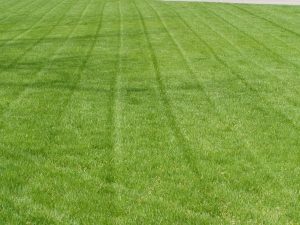 Preparation: Remove existing grass and weeds. Loosen topsoil to a depth of 4-6 inches. If topsoil is brought in, use a minimum of three inches and incorporate into existing soil; layer the area using a rake. Apply starter fertilizer, following bag directions. Do not use weed and feed type fertilizer when installing as sod roots can be damaged. Rake area lightly.
Preparation: Remove existing grass and weeds. Loosen topsoil to a depth of 4-6 inches. If topsoil is brought in, use a minimum of three inches and incorporate into existing soil; layer the area using a rake. Apply starter fertilizer, following bag directions. Do not use weed and feed type fertilizer when installing as sod roots can be damaged. Rake area lightly.
Installation: Install sod immediately upon delivery. Stagger and seam as in bricklaying. Keep snug against each other but not overlapping. After the sod is laid, brush or rake in some topsoil to fill any cracks and roll the lawn to help push the grass roots against the underlying soil. Water deeply to a depth of 4-6 inches. Avoid heavy use of lawn for first 2-3 weeks.
Watering: Water! Keep lawn damp for two weeks. It is important to keep it moist at all times, especially on hot and windy days. The water requirements of plants increase dramatically as the temperature rises about 70 degrees, so if your cool-season sodding program encounters as unseasonable hot spell, don’t spare the water! Check after watering a sod lawn by picking up a corner of one of the sods and seeing if its underside is thoroughly damp.
Mowing: Approximately 7-10 days from time of installation, and as soon as the grass reaches 3 inches, mow 2-2 ½ inches from ground level with a sharp mower. However, never remove more than 1/3 of the grass leaf. After grass has been mowed approximately three times, the grass roots should be deeply enough established so that you can adopt a weekly schedule of watering. But if the weather turns excessively warm and dry, you should be prepared to start more frequent watering again.
MAINTENANCE GUIDELINES:
Proper Watering: Once the sod has knit, it should be watered enough over the first few months to maintain a healthy growing condition. After the sod is well established, continue deep watering at 4-7 day intervals as suggested, depending on soil texture. Water until one inch of water has accumulated in a flat container such as a pie plate. Water during daylight hours as late evening watering during hot weather may create fungus problems.
Proper Fertilization: Apply 6 lbs. Per 1,000 sq. ft. every six weeks FEBRUARY through NOVEMBER. When growth is progressing rapidly fertilizer is essential. The lawn must be fertilized 30 days after installation regardless of the month. The fertilizer used should be complete with a balance of nutrients: nitrogen, phosphorus, and potassium.
Overseeding: To help maintain a dense weed-free turf, we recommend occasional overseeding in September or April following the application rate recommended by Dammann’s.
Good Mowing Practice: Turf should be mowed to a height of 2 ½-3 inches.




